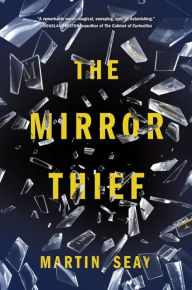The Mirror Thief Presents a Mystery Within a Book Within a Book
It’s hard enough to write one book, but in his doorstopper debut, Martin Seay has written three. The Mirror Thief contains three distinct narratives, set in three cities and three eras, which coalesce in a single twisting, turning, metaphysical journey that’s sure to please fans of David Mitchell and Umberto Eco. Those are exalted names, but the depth of these stories and the straightforward artistry of Seay’s writing will woo those looking for a true literary experience. Mysticism and mystery swirl throughout each narrative, fueled by a book passed down through the ages, understood only by a few in each, and appropriately titled The Mirror Thief.
The Mirror Thief
The Mirror Thief
By Martin Seay
Hardcover $27.95
The three protagonists who carry the action are Curtis, a salty ex-Marine stalking the Las Vegas Strip in search of a compulsive gambler-cum-philosopher from his past; Stanley, the aforementioned gambler whose journey we trace through Venice, California, circa 1958, as he seeks answers about The Mirror Thief; and Crivano, the main character of that book-within-a-book, a 16th-century rogue awash in intrigue and alchemy. Each man is on a quest, searching for solid ground and struggling with concepts of identity and the fantasy of reality. At the center of each story is the mysterious little book of poems and riddles, both perplexing and propulsive in nature.
What Seay does masterfully is imbue each storyline with its own tone and narrative style. Curtis’s view and voice are distinct from Stanley’s, just as Stanley’s are from Crivano’s. To Stanley, The Mirror Thief is a strange book, sure, but also instructive. Gruff Curtis, meanwhile, offers a book review for the ages, culminating in this assessment: “It’s all supposed to be very smart and serious, but at the same time there’s something goofy and Dungeons-&-Dragons about it, too.”
The writing never falters, its beauty lying in its deceptive simplicity. (People don’t turn off lights, the “dark comes in behind them.”) There’s little flowery speech, but not a word is wasted. As Curtis gazes at a woman in the Venetian hotel, for example, he describes her appearance in the neutral musings of a casual observer: “She should be pretty but she’s not. A mistaken idea of pretty. Pretty sketched by somebody who’s never seen it, working off a verbal description.”
To reveal too much about The Mirror Thief‘s supernatural or mystical plot drivers would be to rob you of its immersive sense of discovery, but that one of the settings is Las Vegas is appropriate on a number of levels. A large portion of the modern-day narrative is spent alternately embracing and ruing the ever-changing nature of Sin City, where history seems to crumble day by day. “Las Vegas is a machine for forgetting,” we read, and Curtis, Stanley, and Crivano have plenty they’d like to forget. But there’s always more to learn, another mystery at which to grasp. Magic can be found in a mirror, or a roulette wheel, if you pay attention.
“I know magic ain’t about sawing ladies in half, or telling the future, or changing Coca-Cola into 7-Up,” Stanley tells the author of the book that toys with him. “I know it’s about seeing a pattern in everything. I want you to show me how.”
The three protagonists who carry the action are Curtis, a salty ex-Marine stalking the Las Vegas Strip in search of a compulsive gambler-cum-philosopher from his past; Stanley, the aforementioned gambler whose journey we trace through Venice, California, circa 1958, as he seeks answers about The Mirror Thief; and Crivano, the main character of that book-within-a-book, a 16th-century rogue awash in intrigue and alchemy. Each man is on a quest, searching for solid ground and struggling with concepts of identity and the fantasy of reality. At the center of each story is the mysterious little book of poems and riddles, both perplexing and propulsive in nature.
What Seay does masterfully is imbue each storyline with its own tone and narrative style. Curtis’s view and voice are distinct from Stanley’s, just as Stanley’s are from Crivano’s. To Stanley, The Mirror Thief is a strange book, sure, but also instructive. Gruff Curtis, meanwhile, offers a book review for the ages, culminating in this assessment: “It’s all supposed to be very smart and serious, but at the same time there’s something goofy and Dungeons-&-Dragons about it, too.”
The writing never falters, its beauty lying in its deceptive simplicity. (People don’t turn off lights, the “dark comes in behind them.”) There’s little flowery speech, but not a word is wasted. As Curtis gazes at a woman in the Venetian hotel, for example, he describes her appearance in the neutral musings of a casual observer: “She should be pretty but she’s not. A mistaken idea of pretty. Pretty sketched by somebody who’s never seen it, working off a verbal description.”
To reveal too much about The Mirror Thief‘s supernatural or mystical plot drivers would be to rob you of its immersive sense of discovery, but that one of the settings is Las Vegas is appropriate on a number of levels. A large portion of the modern-day narrative is spent alternately embracing and ruing the ever-changing nature of Sin City, where history seems to crumble day by day. “Las Vegas is a machine for forgetting,” we read, and Curtis, Stanley, and Crivano have plenty they’d like to forget. But there’s always more to learn, another mystery at which to grasp. Magic can be found in a mirror, or a roulette wheel, if you pay attention.
“I know magic ain’t about sawing ladies in half, or telling the future, or changing Coca-Cola into 7-Up,” Stanley tells the author of the book that toys with him. “I know it’s about seeing a pattern in everything. I want you to show me how.”
